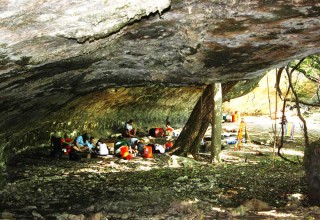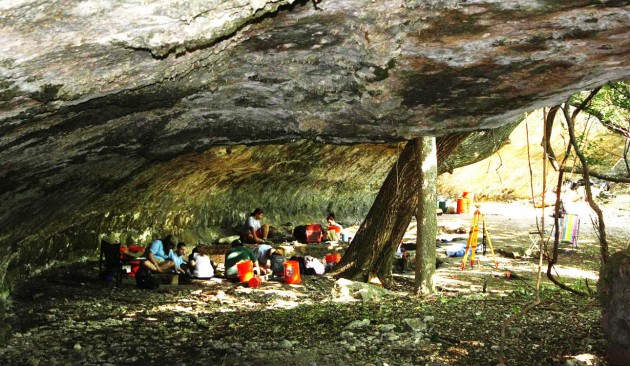
Courtesy Photo
By Ashley Yeaman
Reporter
A group of six Baylor students presented original research about Native Americans from a rock shelter at the Texas Archaeological Society’s annual meeting Friday through Sunday in Dallas.
The Texas Archaeology Society encourages the study, preservation and awareness of archaeology in Texas.
The annual meeting serves as a platform for presentations on archaeological research around the state and also hosts current Texas archaeologists.
The students’ gathered research from a rock shelter near Gatesville in Coryell County, the location of this year’s Texas archaeological field school.
The field school took place from May 16 to June 24, and included three weeks of excavation, one week of lab research and a separate field school sponsored by the Texas Archaeological Society in Hondo.
The experience was led by Carol Macaulay-Jameson, a lecturer of anthropology.
“I’m real proud of [the students] because they all worked really hard,” Macaulay-Jameson said. “It’s all original research that they’ve taken on themselves.”
Student research conducted this summer included surveying the site and focusing on specific archaeological discoveries.
Cypress senior Nathan Fischer, an anthropology and nursing major, researched edible and medicinal plants found at the site.
“I looked at the botany of Native American plants and compared them with medicinal uses to generalize what that plant species could have been used for,” Fischer said.
Fischer said he found the owner of the land on which the site is located, John Barnhill, to be very helpful in his research.
“Mr. Barnhill actually is very interested in nature and the plants he has on his land,” Fischer said. “He was very informative about various trees and shrubs that have existed on his property over time.”
Tom Bean senior Nachelle Williams, a forensic anthropology major, worked with Anna McClain, a 2011 anthropology graduate from Georgetown. Their research looked at more than 2,500 faunal remains at the site.
“We really like bones and so we decided that faunal analysis would be the best,” Williams said. “It was the most in-line with what we want to do in the future.”
Williams said a majority of the bones were determined to be white-tailed deer, along with bison, box turtles, fish and other small mammals.
The students either compiled their research into a paper presentation or a poster to present at the Texas Archaeology Society’s annual meeting. Six of the 10 students who attended the field school travelled to Dallas this weekend to attend the meeting.
Macaulay-Jameson said more than 18,000 lithic flakes and 170 tools were found at the site, along with plant remains, 2,500 animal bones and 2,000 snail shells.
The artifacts date the site from the Middle Archaic to the late Prehistoric period, or roughly from 800 A.D. to 1500 A.D., Macaulay-Jameson said.
“It was during the time when the Native Americans had the bow and arrow,” Macaulay-Jameson said. “We found a lot of arrow points that go into that time period. So this was a site that was continuously habituated for a long time.”
More than 100 rock shelters are known to exist in Central Texas, but Macaulay-Jameson said few have been studied intensively.
“This makes our field school really exciting, that we are actually learning about how people lived in rock shelters,” Macaulay-Jameson said. “I’m excited about going back next year. I’ve been doing some research, and I’ve found that very little on these rock shelters has been tested and investigated, so what we find is going to be very important.”
Fischer said Baylor students’ research on the rock shelter was well-received at the annual meeting.
“Professor Carol Macaulay-Jameson was very happy with the way our presentations went and was told by professors at the convention how much they liked the presentations,” Fischer said. “The poster session also turned out well with great responses from those seeing our posters. Our group made it to quite a few symposiums and was excited to find new and interesting topics emerging in the field of archaeological research.”



